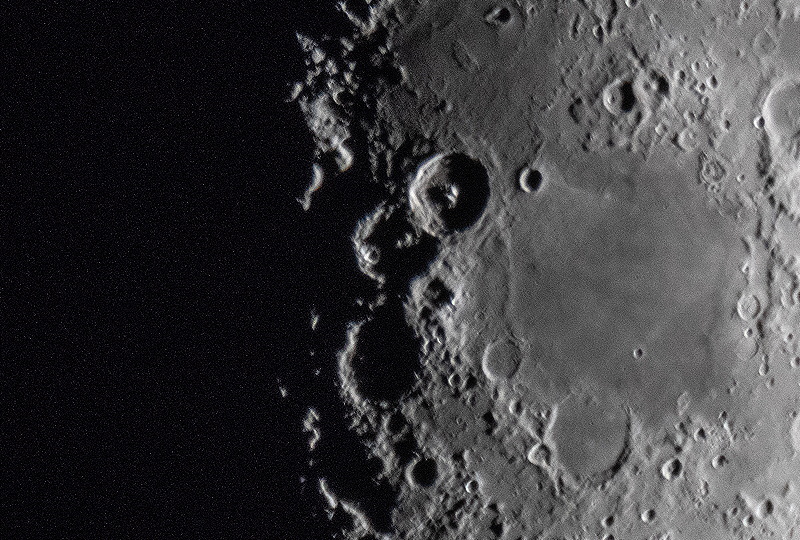More Visitors, Lunar Sunrise;
Extragalactic Supernova Project imaging
Posted: 19 June 2018
|
Open: Monday, 18 June 2018, 1855 MST Temperature: 81°F |
Session: 1252 Conditions: Clear, breezy |
Equipment Used:
12" f/8 LX600 w/StarLock
2" 24mm UWA eyepiece
1.25" 15mm eyepiece
2" 2X PowerMate
Camera:
iPhone 8 Plus
D850 DSLR
1903 MST: LX600 ON, StarLock OFF, High Precision OFF.
Viewed Venus, then the Moon, 102X. Viewed Jupiter, 102X and 163X.
A Curved Bill Thraster (upper right) and a Phainopepla (lower left) came to visit.

1937 MST: sunset. Calm now.
Mounted the iPhone 8 Plus on the 15mm eyepiece. Did some video recordings of Jupiter. This is a stack of 464 video frames afocal 163X taken with NightCap Camera (ISO 100, 1/706sec, 15 seconds):

This is how the Moon looked, D850 DSLR (f/5.6, 1/800sec, FL 300mm), cropped:

I then mounted the D850 DSLR at prime focus + 2X PowerMate. I wanted to capture sunrise at the lunar craters of Theophilus, Cyrillus, and Catharina with an image every 20 minutes over a 2 hour period 2000-2200 MST.
While I was imaging the Moon this spider caught her dinner:

Here are the craters Theophilus, Cyrillus, and Catharina (1/320sec, ISO 2500). Seeing was not very good at times when I was imaging.

Click or tap on image to view video
2031-2128 MST: terminated three Kissing Bugs.
2204 MST: ended lunar imaging. Began checking some galaxies for imaging this night for my Extragalactic Supernova Project. I wanted to be certain the Moon light would not interfere too badly. I viewed M88, M91, M90, M58, M94, and M64, 102X. All were visible. Mounted the D850 at prime focus, focused on the star Denebola.
2221 MST: High Precision ON, StarLock ON.
Took these StarLock autoguided, 5 minutes, ISO 6400, White Balance 4550K, images:
NGC4501 (M88)

NGC4548 (M91)

NGC4569 (M90)

NGC4579 (M58)

NGC4736 (M94)

2356 MST: StarLock OFF, High Precision OFF. Poor seeing frequently caused autoguided issues while imaging these galaxies. Had to stop and restart several of the exposures.
0006 MST: viewed Saturn, 102X and 163X. Seeing definitely not good.
Viewed Mars, low in the southeast, 163X and 102X. Seeing lousy.
0011 MST: LX600 OFF.
|
Close: Tuesday, 19 June 2018, 0023 MST Temperature: 69°F |
Session Length: 5h 28m Conditions: Clear |
Comments are welcome using Email. Twitter users can use the button below to tweet this report to their followers. Thanks.
Cassiopeia Observatory Home Page
Copyright ©2018 Michael L. Weasner / mweasner@me.com
URL = http://www.weasner.com/co/Reports/2018/06/19/index.html
